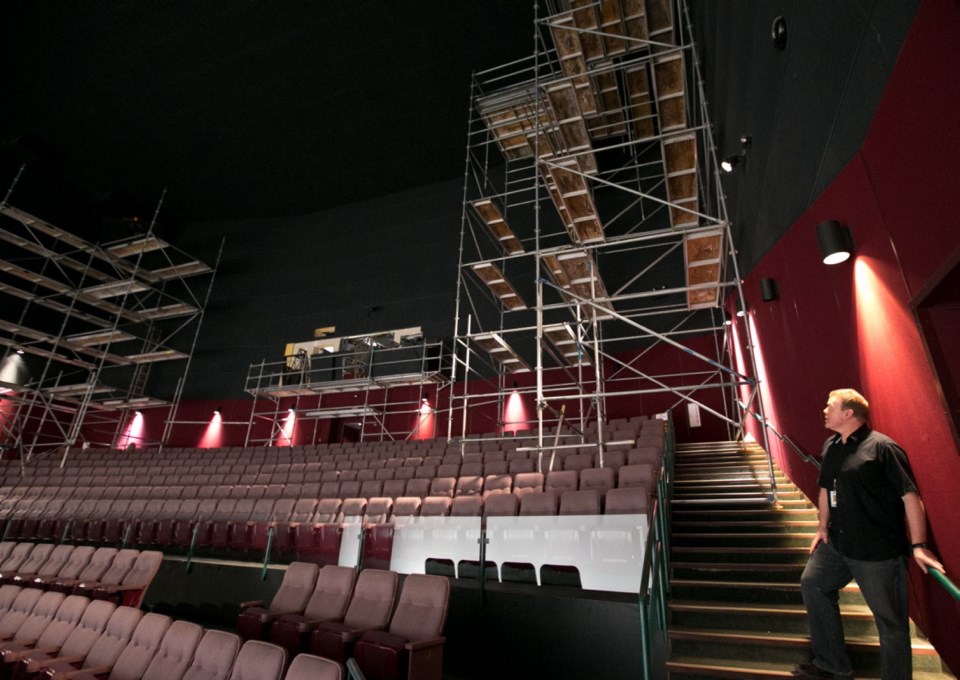Paul Wild was putting it mildly when he cracked a joke during Imax Victoria’s makeover this week.
“Typical Imax — everything has to be super-sized,” quipped Wild, dwarfed by a sub-woofer unit as big as Donald Trump’s ego and a pair of fridge-sized Imax 2k-resolution digital projectors.
The theatre’s director has shut down the theatre in the Royal B.C. Museum until May 12 to facilitate its upgrade to digital projection. The sound system is also being updated. Its massive white screen sheet came down Thursday, giving Wild a chance to see its innards — the tower housing intricate audio equipment — for the first time since he was hired 10 years ago.
The backstage show is just the start of the theatre’s dramatic transition to laser-digital by late 2015, positioning it as one of the first to convert in the Imax world, he said.
Its large auditorium is now full of scaffolding rather than moviegoers to prepare for the strategic installation of overhead and side speakers for its 12-channel sound system and projection booth upgrades. All this action is setting the stage for next year’s piece de resistance — Imax’s next-generation digital laser-projection system that promises greater brightness and clarity.
With few Hollywood releases still available on film, Wild said it was essential to immediately install interim 2k projectors, halfway through the theatre’s 30-year lease with RBCM.
They’ll be positioned side-by-side (“left eye, right eye”) allowing for Imax 3D releases.
The $8.5 million, 400-seat National Geographic Theatre, as it was called when Destination Cinema opened it in June 1998, isn’t abandoning its classic 70-millimetre projection system, however.
While the interim digital upgrade will allow Hollywood feature films to play nightly “on a second-wave basis” in a format somewhat similar to Imax theatres in multiplexes like SilverCity, the theatre’s core, documentary-style films will be shown daily using the Imax GT film-based projector.
“We’re going to use those to bridge the gap,” he said, noting existing digital systems aren’t capable of filling the theatre’s giant 61’ by 85’ screen like those eye-popping Imax film releases.
“What we know is that through geometry, the lens and our throw distance to the screen, we’ll be able to have an image 80-feet-wide,” Wild said. “There are no digital systems in the world right now that will fill that screen, but we want to preserve the giant-screen experience. For Hollywood films which are letterboxed, our digital system should emulate that more closely.”
A “rail system” is being implemented in the theatre’s huge projection booth to transport the massive film and digital projectors and swap them as required. A camera mounted above the projector will act as “a robotic eye” to monitor images on screen and make adjustments, he said.
The booth’s window will also be enlarged and reconfigured so additional images can be beamed.
“It will a juggling act,” said projectionist Hugh Denbigh, who, with associate Jason St. Louis, brings 30 years of projection experience.
One thing that will remain is the Best Booth Award that the theatre, in competition with others worldwide, received eight years ago from Imax Corp.
Other upgrades that are part of the significant investment in the laser package include modifications that will make the H-Vac system forward-compatible.
The decision to move forward wasn’t made lightly, said Wild.
“We always wondered when the appropriate time would be, and it’s now,” he said. “Virtually every film on the slate now is digital-release only with the exception of [Chris Nolan’s November release] Interstellar. Film is disappearing with the exception of guys like Nolan, who continues to shoot on 35-millimetre.”
Wild got to meet Nolan while in Los Angeles last November with exhibitors for a sneak preview of a new 4K laser digital projection system. Imax is co-developing the system with the technology company Barco, using patents exclusively licensed from Eastman-Kodak.
“Because Chris loves Imax so much they arranged a tour of the set,” said Wild.
Wild, who had to sign a confidentiality agreement, said Nolan has ensured his sci-fi adventure will open on 50 Imax film-based systems.
One reason Imax Victoria made its digital decision was because of support from the local market and annual passholders, Wild said.
“It’s not because of the tourism market,” he said. “When the theatre was built it was for 65 per cent visitors and 35 per cent local, and now it’s almost the other way around.”
It will make Imax Victoria one of the first theatres in the world to install the new technology, along with the Smithsonian in Washington, D.C., and theatres in Sydney, Melbourne and Seattle.
One of the makeover’s most eye-catching aspects that could be a show in itself will unfold Tuesday, when the theatre’s new 1,200-pound silver screen rolls into town.
After being unloaded from crates on a flatbed truck, it will be carried by hand into the theatre.
To check out progress on the upgrade you can check out webcam footage at imaxvictoria.com.
